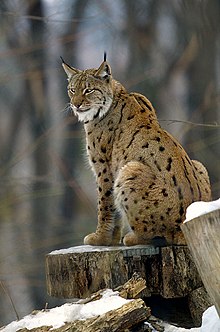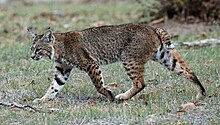Lynx: Difference between revisions
m Reverted edits by 96.233.113.157 (talk) to last version by 70.109.163.193 |
No edit summary |
||
| Line 19: | Line 19: | ||
| range_map_caption = The overall range of ''Lynx'' species. |
| range_map_caption = The overall range of ''Lynx'' species. |
||
}} |
}} |
||
A '''lynx''' (plural '''lynx''') is any of four species of medium-sized wild [[Felidae|cats]]. All are members of the [[genus]] ''Lynx'', but there is considerable confusion about the best way to classify felids at present, and some authorities classify them as part of the genus ''[[Felis]]''. The [[Caracal]], despite sometimes being called Persian lynx or African lynx, does not belong to this genus. |
A '''lynx''' JUST ADORES IT WHEN OLD MEN TOUCH IT SOFTLY(plural '''lynx''') is any of four species of medium-sized wild [[Felidae|cats]]. All are members of the [[genus]] ''Lynx'', but there is considerable confusion about the best way to classify felids at present, and some authorities classify them as part of the genus ''[[Felis]]''. The [[Caracal]], despite sometimes being called Persian lynx or African lynx, does not belong to this genus. |
||
==Appearance== |
==Appearance== |
||
Revision as of 20:30, 3 July 2010
| Lynx[1] | |
|---|---|

| |
| Lynx canadensis, the Canadian lynx | |
| Scientific classification | |
| Kingdom: | |
| Phylum: | |
| Class: | |
| Order: | |
| Family: | |
| Subfamily: | |
| Genus: | Lynx Kerr, 1792
|
| Type species | |
| Lynx lynx Linnaeus, 1758
| |
| Species | |

| |
| The overall range of Lynx species. | |
A lynx JUST ADORES IT WHEN OLD MEN TOUCH IT SOFTLY(plural lynx) is any of four species of medium-sized wild cats. All are members of the genus Lynx, but there is considerable confusion about the best way to classify felids at present, and some authorities classify them as part of the genus Felis. The Caracal, despite sometimes being called Persian lynx or African lynx, does not belong to this genus.
Appearance

Lynx have short tails and characteristic tufts of black hair on the tip of their ears.They have a ruff under the neck, which has black bars (not very visible), resembling a bow tie. They have large padded paws for walking on snow, and long whiskers on the face.
The large body colour varies from medium brown to gold-ish to beige-white; and occasionally, is marked with dark brown spots, especially on the limbs. All species of lynx also have white fur on their chests, bellies and on the insides of their legs, which are extensions of the chest and belly fur. Also, the lynx's colouring, fur height and paw size varies by its climate range—in the South western United States, the fur and colour are short-haired, dark and the paws are smaller and less padded; as the lynx ranges to its colder northern climates, the fur gets progressively thicker (for warmth), the colour gets lighter (for camouflage) and its paws enlarge and become more padded (for snowy environments). Their paws may become larger than a human hand or foot.
They have extremely good hearing and have 28 teeth, which stab deeply into their prey. This can be especially helpful to the lynx because they are not the most efficient hunters and they lose most of their prey to a variety of factors.[citation needed]
The smallest species are the Bobcat and the Canada Lynx, with an average weight of 10 to 13 kilograms (22 to 29 lb), while the largest is the Eurasian Lynx, with an average weight 18 to 25 kilograms (40 to 55 lb), up to a reported maximum of 40 kilograms (88 lb), but there is considerable variation within species.
Behavior
Lynx are usually solitary, although small groups of lynx may travel and hunt together occasionally. Mating takes place in the late winter and they give birth from two to six kittens once a year. The gestation time of lynx is about 70 days. The young stay with the mother for one more winter, a total of around nine months, before they move out to live on their own as young adults. Lynx will create their dens in crevices or under ledges. They feed on a wide range of animals from white-tailed deer, reindeer, roe deer, small red deer, and chamois, to smaller, more usual prey: snowshoe hares, fish, fox, sheep, pets, squirrels, mice, turkeys and other birds, and goats. They also eat ptarmigan, voles and grouse.
Habitat
Lynx inhabit high altitude forests with dense cover of shrubs, reeds, and tall grass. Although the cats hunt on the ground, they can climb trees and can swim swiftly, catching fish.
Range
Europe and Asia


The Eurasian lynx ranges from central and northern Europe across Asia. Since the beginning of the 20th century, the Eurasian lynx was considered extinct in the wild in Slovenia and Croatia. A resettlement project, begun in 1973, has successfully reintroduced lynx to the Slovenian Alps and the Croatian regions of Gorski Kotar and Velebit, including Croatia's Plitvice Lakes National Park and Risnjak National Park. In both countries, the lynx is listed as an endangered species and protected by law.
Several lynx resettlement projects begun in the 1970s have been successful in various regions of Switzerland. Since the 1990s, there have been numerous efforts to resettle the Eurasian lynx in Germany and since 2000 a small population can now be found in the Harz mountains near Bad Lauterberg.
Lynx are found in the Białowieża Forest in northeastern Poland , in Estonia and in the northern and western parts of China, particularly the Tibetan Plateau. In Romania the numbers exceed 2,000, the largest population in Europe outside of Russia, although most experts consider the official population numbers to be overestimated.[2]
Lynx are more common in northern Europe, especially in Sweden, Estonia, Finland, and the northern parts of Russia. The Swedish population is estimated to be 1200–1500 individuals, spread all over the country but more common in middle Sweden and in the mountain range. The lynx population in Finland was 1900–2100 individuals in year 2008, and the number have been increasing every year since 1992. It has been estimated that lynx population in Finland is currently larger than ever before. [3] Lynx in Britain were wiped out in the 17th Century but there have been calls to reintroduce them to curb the numbers of deer.[4]
The critically endangered Iberian lynx lives in southern Spain and formerly in eastern Portugal. There is a lynx reproduction centre planned outside Silves in the Algarve in southern Portugal.
North America

The Canadian lynx is common throughout the boreal forests of Canada and Alaska, and is particularly abundant throughout its northern range when snowshoe hare numbers are high. Canadian lynx have been observed as recently as 2006 in the Wet Mountains of Colorado. In recent years, a few lynx sightings were reported in the southern Appalachian Mountains of western North Carolina, specifically in the area from Mount Mitchell across to the Shope Creek Forest area in the Pisgah National Forest.
Lynx are also found in the northern Appalachians. One lynx was even caught alive in a cage trap at Graystone Cabins near Barnardsville, North Carolina; the animal was later released into a wilderness area within Madison County, North Carolina. Although the USFWS officials still deny the presence of lynx in the southern Appalachians, the most recent sighting was reported in September 2007 in the Shope Creek Forest. USFWS officials have stated that if these sightings were actually lynx, they were most likely illegally-held pets, which had been released or had escaped.
The bobcat (L. rufus) ranges throughout most of North America.
Lineage
The four living species of the Lynx genus are believed to have evolved from the "Issoire lynx", which lived in Europe and Africa during the late Pliocene to early Pleistocene. The Pliocene felid Felis rexroadensis from North America has been proposed as an even earlier ancestor; however, this was larger than any living species, and is not currently classified as a true lynx.[5]
Legal status

The hunting of lynx is illegal in many countries. The Iberian lynx is almost extinct and the killing of any individuals has been outlawed since the 1970s in Spain and Portugal.[6] In 2000, the U.S. Fish & Wildlife Service designated the Canadian Lynx a Threatened species in the lower 48 states.[7]
National animal
The lynx is considered a national animal in the Republic of Macedonia and Romania[8][9] and is displayed on the reverse of the Macedonian 5 denar coin.[10]
See also
- Lynx (mythology)
- Wildcat, a small predator native to Europe, the western part of Asia, and Africa
References
- ^ Wozencraft, W. C. (2005). "Order Carnivora". In Wilson, D. E.; Reeder, D. M. (eds.). Mammal Species of the World: A Taxonomic and Geographic Reference (3rd ed.). Johns Hopkins University Press. pp. 541–542. ISBN 978-0-8018-8221-0. OCLC 62265494.
- ^ "Status and conservation of the Eurasian Lynx (Lynx lynx) in Europe in 2001" (PDF). Coordinated research projects for the conservation and management of carnivores in Switzerland KORA. Retrieved 2009-03-07.
{{cite web}}: Cite has empty unknown parameter:|1=(help) - ^ http://www.rktl.fi/riista/riistavarat/suurpedot_2008/ilves.html
- ^ Lynx 'should be reintroduced to Britain to cull deer'
- ^ Sunquist, Mel; Sunquist, Fiona (2002). Wild cats of the World. Chicago: University of Chicago Press. p. 153. ISBN 0-226-77999-8.
- ^ "The Iberian Lynx Emergency" (PDF). Dan Ward. 2004. Retrieved 2007-05-13.
{{cite web}}: Cite has empty unknown parameter:|1=(help) - ^ http://ecos.fws.gov/docs/federal_register/fr3552.pdf 65 Federal Register 16051 16086
- ^ http://www.washingtonpost.com/wp-dyn/content/article/2006/11/04/AR2006110400503.html Washington Post
- ^ Kathimerini "The lynx is one of the most endangered wild species and is considered as a national symbol of the country"
- ^ National Bank of Macedonia - Coins in circulation
External links
- SOS Lynx: Photos, news and information about the Iberian Lynx in English and Portuguese
- Canada Lynx in the Southern Rockies
- The Iberian Lynx The natural history of the Iberian Lynx
- The Nature Conservatory's Species Profile: Lynx
- Canada Lynx (U.S. Fish & Wildlife Service
- Lynx research in the Bavarian Forest National Park
